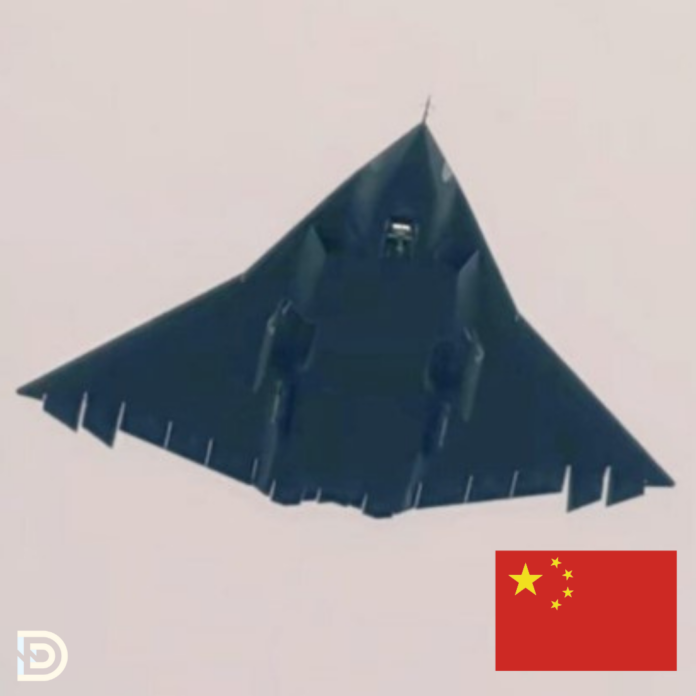China has taken another step forward in military aviation with the latest test flight of its rumored sixth-generation fighter, the J-36. A recently surfaced video shows the aircraft soaring against the sunset in Chengdu, the home of Chengdu Aircraft Corporation.
Mysterious Jet Takes Flight Once Again
This marks the third flight in just a few months, adding to speculation that China is aggressively advancing its next-generation air combat capabilities.
The video shows a sleek, tailless aircraft flying at low altitude over an urban area near a known aerospace facility. Military analysts have linked the jet to earlier sightings in December and a subsequent flight earlier this year.
Unlike its first recorded flight, which was accompanied by a J-20S stealth fighter, this latest flight had no escort. This suggests that engineers are becoming more confident in the aircraft’s stability and reliability.
China’s Veiled Warning to US; WZ-9 Drone Could Detect F-35 and B-21
The timing of these test flights has sparked further curiosity. China has a history of showcasing military advancements at key moments. The first flight reportedly took place on a significant national date, and now, the latest one comes as the United States struggles with its own next-generation fighter program.
The rapid pace of these tests suggests that China is making progress in stealth and high-speed capabilities, areas where the U.S. has long dominated.
J-36’s Advanced Features and Strategic Importance
The J-36’s design has raised many questions among experts. It features a tailless, double-delta wing structure, which improves stealth by reducing radar reflections. What stands out even more is its rumored three-engine configuration, with two side intakes and a third intake on top. If true, this would be an unusual choice, possibly designed for high-speed performance and extended range.
J-35 Acquisition: Pakistan to Get China’s Stealth Marvel
Another major highlight is the aircraft’s weapons bay. Analysts estimate it to be around 25 feet long, large enough to carry powerful missiles. This suggests the jet may be built for beyond-visual-range combat, launching missiles from far distances before an enemy even sees it. Some experts believe it could also serve as a command center for unmanned aircraft, further increasing its combat effectiveness.
China’s ability to rapidly develop and test-fly such an advanced jet signals its growing confidence. The country has already introduced stealth fighters like the J-20, but the J-36 represents a major leap forward. If reports about its powerful WS-10C or WS-15 engines are accurate, this aircraft could rival even the most advanced American fighters.
Boeing Stuns Defense World with $20 Billion F-47 NGAD Win, Lockheed Falls Hard
While details remain scarce, the J-36’s frequent test flights indicate that China is serious about its next-generation air power. These tests come at a time when the U.S. is struggling with its own sixth-generation fighter program, the Next Generation Air Dominance (NGAD) initiative.
China’s Aggressive Pace vs. U.S. Challenges
The United States has been developing NGAD for over a decade, with plans to replace the aging F-22 and F-35. A prototype reportedly flew as early as 2020, but the program has faced delays and rising costs. Some estimates suggest that each NGAD jet could cost as much as $300 million, raising concerns about affordability. The program was temporarily halted last year, and its future remains uncertain.
In contrast, China appears to be accelerating its progress. The frequent test flights of the J-36, combined with the unveiling of another sixth-generation prototype from Shenyang Aircraft Corporation, show that China is pushing hard to advance its air combat capabilities. The absence of official statements from Beijing has led to widespread speculation about its true capabilities and timeline for deployment.
https://www.youtube.com/watch?v=_gUmuBYiuEQ
The global military balance is shifting as other nations also race to develop next-generation fighters. The UK, Japan, and Italy’s Global Combat Air Programme is aiming for a 2035 launch, while France, Germany, and Spain’s Future Combat Air System moves at a slower pace. Russia’s MiG-41 remains in early development.
Russia’s MIG 41 May Outclass F-35
China’s decision to conduct these flights in full public view adds another layer to the discussion. While the United States has kept its NGAD program highly secretive, China is taking the opposite approach, possibly as a show of strength. With the J-36 now appearing in its third recorded flight, its presence can no longer be ignored.
These developments raise important questions about the future of air superiority. While it remains unclear when the J-36 will enter service, its rapid progress sends a strong message to the world.







